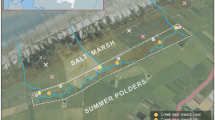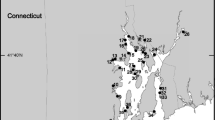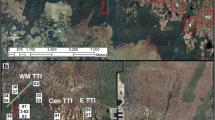Abstract
Vegetation change in response to restriction of the normal tidal prism of six Connecticut salt marshes is documented. Tidal flow at the study sites was restricted with tide gates and associated causeways and dikes for purposes of flood protection, mosquito control, and/or salt hay farming. One study site has been under a regime of reduced tidal flow since colonial times, while the duration of restriction at the other sites ranges from less than ten years to several decades. The data indicate that with tidal restriction there is a substantial reduction in soil water salinity, lowering of the water table level, as well as a relative drop in the marsh surface elevation. These factors are considered to favor the establishment and spread ofPhragmites australis (common reed grass) and other less salt-tolerant species, with an attendant loss ofSpartina-dominated marsh. Based on detailed vegetation mapping of the study sites, a generalized scheme is presented to describe the sequence of vegetation change from typicalSpartina- toPhragmites-dominated marshes. The restoration of thesePhragmites systems is feasible following the reintroduction of tidal flow. At several sites dominated byPhragmites, tidal flow was reintroduced after two decades of continuous restriction, resulting in a marked reduction inPhragmites height and the reestablishment of typical salt marsh vegetation along creekbanks. It is suggested that large-scale restoration efforts be initiated in order that these degraded systems once again assume their roles within the salt marsh-estuarine ecosystem.
Similar content being viewed by others
Literature cited
Beals, W., and P. Westover. 1971. The Pine Creek and Mill River watersheds, Fairfield, Connecticut: an ecological guide to open space and land use. Fairfield Conservation Commission, Fairfield, CT. 55 pp.
Clark, J. 1977. Coastal ecosystem management: a technical manual for the conservation of coastal zone resources. John Wiley and Sons, New York, NY. 928 pp.
Daiber, F. C. 1982. Animals of the tidal marsh. Van Nostrand Reinhold Co. Inc., New York, NY. 422 pp.
De la Cruz, A. A. 1978. The production of pulp from marsh grass.Econ. Bot. 32:46–50.
Frankowski, B., F. Hernandez, T. Okron, and S. Bongiorno. 1977. Increase in abundance ofSolidago sempervirens on a diked salt marsh in southwestern Connecticut.Bull. Torrey Bot. Club 104:383–385.
Halsam, S. M. 1971. The development and establishment of young plants ofPhragmites communis Trin.Ann. Bot. 35:1059–1072.
Halsam, S. M. 1972. Biological flora of the British Isles:Phragmites communis Trin.J. Ecol. 60:585–610.
Horwitz, E. L. 1978. Our nation's wetlands. Council on Environmental Quality, Washington, DC. 70 pp.
Hutchinson, J. N. 1980. The record of peat wastage in the East Anglian fenlands at Holme Post, 1848–1978 AD.J. Ecol. 68:229–249.
Miller, W. R., and F. E. Egler. 1950. Vegetation of the Wequetequock-Pawcatuck tidal marshes, Connecticut.Ecol. Monogr. 20:143–172.
Niering, W. A., and R. M. Bowers. 1966. Our disappearing tidal marshes.In Connecticut's coastal marshes: a vanishing resource. Connecticut Arboretum Bull., No. 12. 36 pp.
Niering, W. A., and R. S. Warren. 1980. Vegetation patterns and processes in New England salt marshes.BioScience 30:301–307.
Niering, W. A., R. S. Warren, and C. G. Weymouth. 1977. Our dynamic tidal marshes: vegetation changes as revealed by peat analysis. Connecticut Arboretum Bull., No. 22. 12 pp.
Nixon, S. W. 1980. Between coastal marshes and coastal waters—a review of twenty years of speculation and research on the role of salt marshes in estuarine productivity and water chemistry. Pages 437–525in P. Hamilton and K. B. Macdonald, eds. Estuarine and wetland processes: with emphasis on modelling. Marine Science Vol. II. Plenum Press, New York, NY.
Roman, C. T. 1978. Tidal restriction: its impact on the vegetation of six Connecticut coastal marshes. M.A. Thesis, Connecticut College, New London, CT. 178 pp.
Roman, C. T. 1981. Detrital exchange processes of a Delaware salt marsh. Ph.D. Dissertation, University of Delaware, Lewes, DE. 144 pp.
Sipple, W. S. 1971. The past and present flora and vegetation of the Hackensack Meadows.Bartonia 41:4–56.
Steever, E. Z., R. S. Warren, and W. A. Niering. 1976. Tidal energy subsidy and standing crop production ofSpartina alterniflora.Est. Coastal Mar. Sci. 4:473–478.
Author information
Authors and Affiliations
Rights and permissions
About this article
Cite this article
Roman, C.T., Niering, W.A. & Warren, R.S. Salt marsh vegetation change in response to tidal restriction. Environmental Management 8, 141–149 (1984). https://doi.org/10.1007/BF01866935
Issue Date:
DOI: https://doi.org/10.1007/BF01866935




